Imagine stepping into a lush, verdant oasis in the heart of your home – that’s the enchanting world of the spider plant. These resilient and adaptable houseplants have captivated gardeners for generations. They are known for their unique cascading foliage and vibrant green hues. But to keep these natural wonders thriving, understanding their light requirements is key.
Originating from the tropical regions of Africa, spider plants have evolved to thrive in a wide range of lighting conditions. They can adapt to bright, indirect sunlight or more modest low-light environments. To ensure your spider plant reaches its full potential, it’s essential to provide the optimal light conditions throughout the year.
Key Takeaways
- Spider plants prefer bright, indirect sunlight for optimal growth and vibrant foliage.
- Adjusting light levels throughout the year is essential to meet the plant’s evolving needs.
- Proper positioning, monitoring for signs of over or under-exposure, and utilizing artificial lighting when necessary are key to maintaining healthy spider plants.
- Spider plants can tolerate low-light conditions but will grow more slowly and may not bloom as readily.
- Direct sunlight can scorch the leaves, so it’s important to provide the right balance of light for your spider plant.
Understanding Spider Plant’s Light Needs
Spider plants come from the tropical forest and can adjust to many light conditions. They love the dappled sunlight under the forest canopy. This light is perfect for them, helping them grow well in bright, indirect light or softer lighting.
Ideal Light Conditions for Indoor Growth
Inside, spider plants do best near bright, indirect light. East or west-facing windows are ideal. The filtered sunlight is just right for these plants. They can also handle less light, making them great for places with little sun.
Year-Round Light Considerations
Light changes with the seasons, and spider plants need you to keep up. In winter, they might need a spot near the window or extra light. In summer, a sheer curtain can protect them from too much sun and prevent damage.
“Spider plants crave bright, indirect light, making them a versatile choice for indoor spaces that aren’t sun-soaked.”
Providing Adequate Light Throughout the Year
Adjusting your spider plant’s light as seasons change is key to keeping it happy. In winter, when sunlight is less, your plant might need extra help. Place it near a bright window and think about using grow lights to mimic sunlight and keep it healthy.
Spring and Summer Light Management
Spring and summer mean your spider plant wants more sun. But, it should get indirect light to stay healthy. Avoid the strong midday sun to prevent leaf burn. Think of your plant as a celebrity avoiding the paparazzi to keep it safe.
Fall Light Adjustment
With shorter days in fall, adjust your spider plant’s light. Keeping its light consistent is important, like a favorite TV show. You might need to move the plant or change your lights. Being consistent helps your plant stay stress-free.
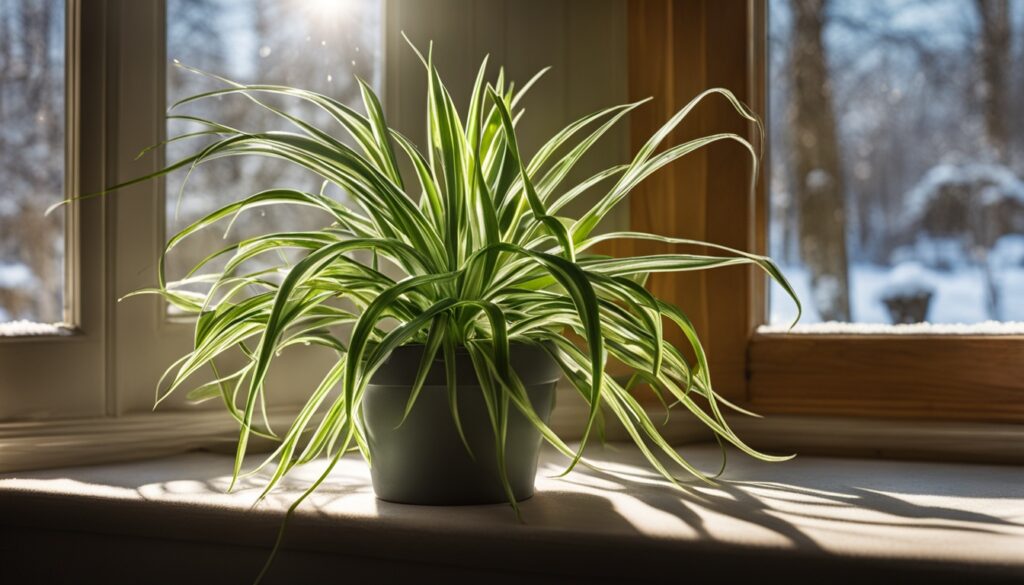
“Providing the right amount of light is essential for the health and growth of spider plants. Consistency is key to ensuring your plant thrives throughout the year.”
Impact of Excessive Light
Spider plants are adaptable but can suffer from too much light. Signs like leaf damage and stress show your plant gets too much light. Too much direct sunlight can cause browning or spotting on the leaves. This can harm the plant’s health and look.
To keep your spider plant safe from too much light, watch out for intense sunlight or reduce grow lights. Plants need a break from the spotlight too. Curly Spider Plants do well in bright, indirect light. It’s key to keep the light balanced to avoid damage.
- Signs of too much light for spider plants include droopy leaves, crisp texture, leaf burn, and dry soil.
- Immediate actions for leaf damage from too much light include moving the plant to a shadier spot, watering it, cutting off crispy parts, and watching it recover.
- Long-term care adjustments for protecting spider plants from intense sunlight involve rotating the plant, checking on it seasonally, and keeping humidity levels right.
By managing your spider plant’s light carefully, you can keep its lush, arching foliage thriving. This ensures a healthy, green indoor space.
“Spider Plants need bright indirect light to thrive and should be positioned accordingly to avoid issues from excessive lighting.”
Monitoring and Adjusting Light Levels
Spider plants are tough but have limits. If you see pale or discolored leaves, it means your plant needs more light. Not enough light can hurt the plant’s look, growth, and health.
Signs of Inadequate Light
- Stunted growth from lack of light
- Discolored leaves from insufficient light
Preventing Light-Related Issues
To stop problems like leggy growth, change your spider plant’s light setup. Try moving the plant or using mirrors to reflect light. This helps spread the light evenly, giving your plant the right amount of attention.
Avoiding Direct Sunlight
Too much sunlight can cause leaf burn. Avoid the strong midday sun. Bright, indirect light is best for your spider plant.
Artificial Light Sources
Grow lights are great for indoor gardens. Pick full-spectrum bulbs with a color temperature around 6000K-6500K to act like natural daylight. Keep them 12-24 inches from your spider plant. This way, you get the sun’s benefits without the burn.
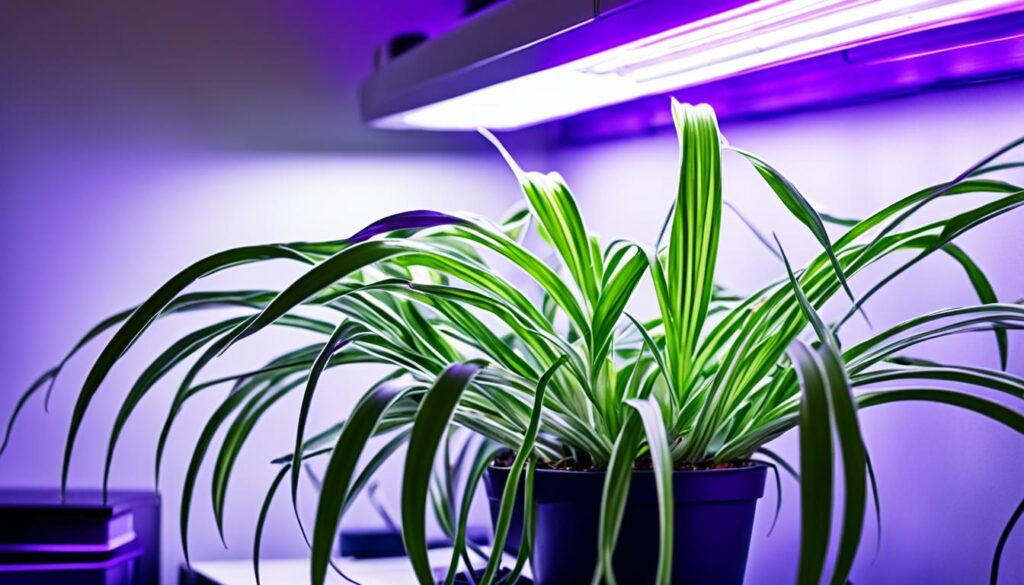
Outdoor Considerations for Year-Round Light
When growing spider plants outside, managing light is crucial. These plants do well in bright, indirect light with some shade. This protects them from the sun’s strong rays. Don’t put your spider plants in direct sunlight as it can burn their leaves and slow their growth.
Shaded Bliss for Outdoor Spider Plants
Spider plants love light shade, similar to their natural habitat. They do best in dappled sunlight or with shade filtering the sun. This keeps them safe from the sun’s intense rays.
Acclimating Indoor Plants to the Great Outdoors
When moving indoor spider plants outside, do it slowly. Start by placing them in a shaded area and gradually expose them to more light. This protects them from sunburn. Increase their light exposure over time for a smooth outdoor transition.
Winter Woes and Light Lows
In winter, spider plants may look less vibrant due to shorter days. You might need to add extra light or bring them inside. This ensures they get enough light to stay healthy during the cold months.
Summer Lovin’ and Light Levels
Spider plants love the sun in summer. But, too much sun can harm them. Use shade to filter the sun’s rays and keep them healthy.
Fall’s Fading Light
As fall arrives, spider plants need less light. Adjust their light in fall to prepare for winter. Watch their needs and make changes slowly to help them through the seasons.
What are the light requirements for a spider plant?
Spider plants are tough and can grow well in many indoor light settings. But, to keep your spider plant healthy and bright, knowing its ideal light needs is key.
These plants do best in medium light, needing 4-6 hours of bright, indirect sunlight daily. They can handle less light but won’t grow or stay healthy. On the other hand, too much direct sunlight can hurt the leaves and change their color.
To give your spider plant the ideal light conditions, put it in an east or west-facing window. This way, it gets gentle, filtered sunlight. Don’t put it in direct midday sun, as it’s too harsh and stressful.
Adjusting Light Levels Seasonally
Seasons change, so adjust your spider plant’s light as needed:
- In winter, bring your spider plant closer to a sunny window for enough light.
- In spring and summer, watch its growth and color. Move it if needed to avoid leaf burn from too much sun.
- In fall, as days get shorter, put your spider plant in a bit shadier spot to keep it from getting stressed.
By watching and adjusting your spider plant’s light all year, you help it stay bright and healthy indoors.

“Spider plants are known for their ability to tolerate a wide range of light conditions, but they truly flourish when provided with the right amount of bright, indirect light.”
Impact of Light on Flowering
Spider plants bloom when they get enough light. Bright, indirect light makes them produce white flowers. In summer, with longer days, they bloom more. But in winter, you might need to use artificial light to help them bloom.
The amount of light spider plants need changes with the seasons. In summer, they love bright, indirect light for 12 hours a day. This makes them bloom a lot. As fall comes and days get shorter, they bloom less. To keep them blooming in winter, give them 12-14 hours of artificial light a day.
Knowing what light spider plants need at different times of the year helps them bloom well. By changing the light they get, you can make sure they keep producing those beautiful white flowers. This makes them a great part of any indoor garden.
“Proper lighting is essential for spider plants to bloom and thrive. By providing the right amount of light at the right times, you can enjoy their vibrant flowers year-round.”
Light’s Role in Propagation
Light is key when you’re growing your spider plant. It needs 8-10 hours of indirect sunlight every day to root and grow well. If sunlight is scarce, use artificial lights with full-spectrum bulbs, keeping them 12-24 inches from your plants.
Adjust the light as the seasons change. In winter, give 6-8 hours of light. In summer, increase it to 8-14 hours. This helps your spider plant cuttings get the right amount of light they need to grow strong.

Good lighting is essential for your spider plant cuttings to root and grow. By giving them the right amount of light, you help them succeed. Adjusting the light seasonally ensures your spider plants get enough light all year, promoting healthy growth.
Adjust your Spider Plant’s Light Exposure with the Seasons
As seasons change, so do your spider plant’s light needs. Keep an eye on it and adjust its spot to help it thrive all year. In winter, use more sunlight or grow lights to feed your spider plant. In spring and summer, give it bright, indirect light but protect it from the strong midday sun.
As fall comes, cut back on the light to match the shorter days. By changing your spider plant’s light needs with the seasonal light changes, you keep it in the best light for healthy growth.
Mastering Year-Round Light Management
- Winter: Maximize sunlight or use grow lights to compensate for shorter daylight hours.
- Spring and Summer: Provide bright, indirect light, protecting from intense midday sun.
- Fall: Gradually reduce light exposure to match the fading daylight.
Pay attention to your spider plant’s light needs and adjust as seasons change. This is key to maintaining optimal light for spider plants year-round. With flexibility and care, your spider plant will grow well and look great.
“Adapting to the changing light conditions is essential for the health and vitality of spider plants.”
By adapting spider plant light needs through the year, you make sure your plant gets the right amount of light. With care and attention, your spider plant will keep thriving and add a touch of the tropics to your home.
Spider Plant Care: Light Requirements and Watering Needs
Caring for a spider plant means more than just giving it the right light. It’s also key to water it right to keep it healthy. Spider plants do best in medium light conditions. Make sure they don’t get too much direct sunlight, as it can burn their leaves.
These plants can handle different light levels but will flourish in brighter spots. They need 4-6 hours of bright, indirect light daily. In winter, they might need 6-8 hours of light. But in summer, they can take 8-14 hours of light, showing how important it is to adjust the light with the seasons.
When watering, spider plants just need a light drink every week or so. They need less water in autumn and winter. It’s important to not let the soil get too wet, as overwatering can cause leaf problems, root rot, and stress the plant. Water your spider plant when the top two inches of soil feel dry.
By giving your spider plant the right balance of light and water, it will stay healthy and thrive. These plants are easy to care for and are great air purifiers. They make a wonderful addition to any indoor space.
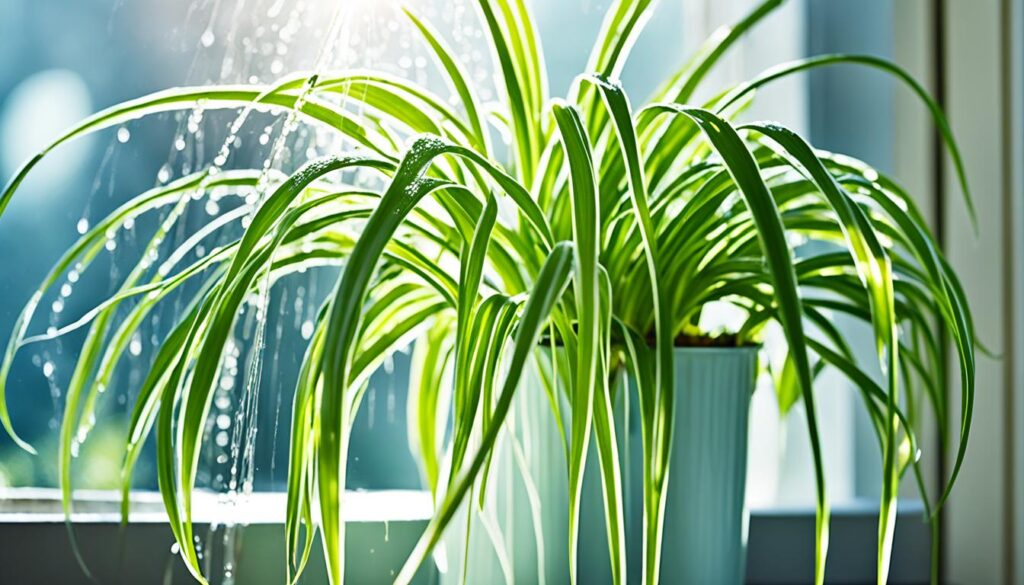
“Spider plants are known to purify indoor air. However, it would require a large number of plants to significantly improve air quality in a home or office.”
How Much Light Does a Spider Plant Need?
Spider plants are known for their toughness and ability to grow in different light levels. To help them grow well, knowing the ideal light levels for spider plants is key.
These plants prefer at least 4 to 6 hours of bright, indirect light daily. This light helps them grow strong and stay healthy. They can survive in less light, but they’ll look better with the right amount.
The spider plant light requirements change with the seasons and your environment. In spring and summer, they need more light. In winter, they can get by with less.
To make sure your spider plant gets enough light, watch how it grows and looks. If the leaves get thin or lose their color, it might not have enough light. If they look burned or wilted, it has too much direct sunlight.
https://www.youtube.com/watch?v=wiJ_PFgCQ2c
By giving your spider plant the ideal light conditions, you’ll help it thrive. You’ll enjoy its lush, healthy look for many years.
How Often to Water a Spider Plant?
Keeping the right watering schedule is crucial for a healthy spider plant. Spider plants don’t need a strict watering plan. Their needs change with sunlight, temperature, and season.
Generally, water your spider plant once a week. Check the top two inches of soil. Water when it feels dry. Overwatering can harm your plant as much as underwatering.
- In warmer months, your spider plant may need watering twice a week as the soil dries out faster.
- During the cooler, winter months, watering once a week is usually sufficient.
- Always use rain or distilled water as spider plants are sensitive to the chlorine and fluoride found in tap water.
Signs your spider plant needs water include wilting leaves or a drooping look. Yellowing or mushy leaves might mean you’re overwatering. Watch your plant closely and adjust your watering as needed for best health.
“Spider plants are generally considered easy-to-care-for plants, making them a great choice for beginners.”
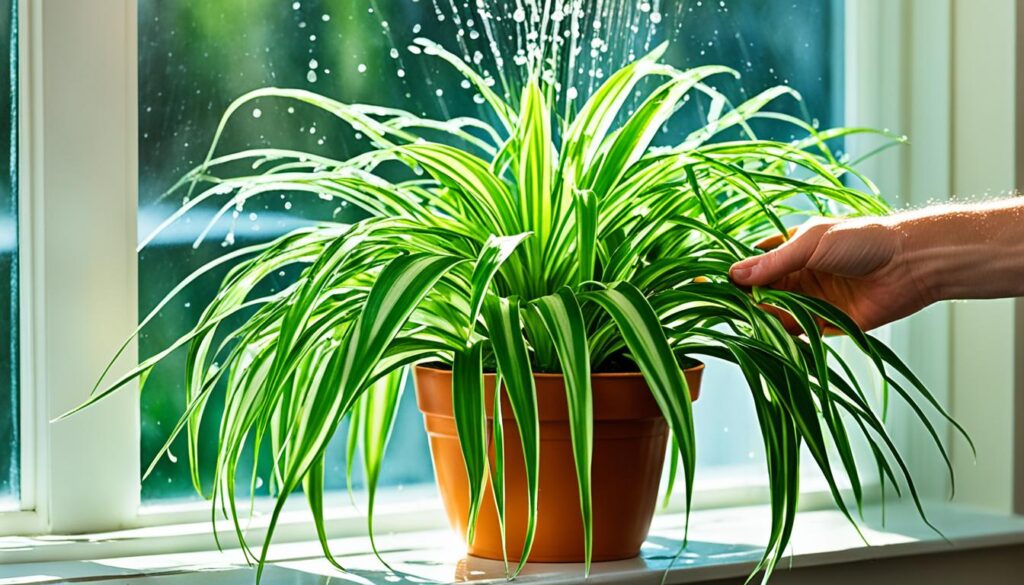
A healthy spider plant gets the right water at the right time. Keep an eye on your plant’s soil moisture and adjust your watering schedule for spider plants as needed. This way, your spider plant will thrive for years.
Spider Plant: Soil & Fertilizer
For a spider plant to grow well, it needs the right soil and food. They do best in well-draining, loamy soil with a neutral pH. They can also handle slightly acidic or alkaline soil. A balanced fertilizer during the growing season helps them stay lush and produce those beautiful plantlets.
It’s best to repot your spider plant in early spring or summer. This is when the roots get too tight and the plant looks rootbound. Moving it to a bigger pot with fresh, rich soil will help it keep thriving.
- Ideal soil for spider plants is well-draining, loamy, and has a neutral pH
- Use a balanced, all-purpose fertilizer every 2-4 weeks during spring and summer
- Repot spider plants in early spring or summer when they become rootbound
By giving your spider plant the ideal soil and fertilizer, it will stay healthy and look great. With proper care, these plants will give you lots of beautiful leaves and plantlets for many years.
“Spider plants are one of the easiest houseplants to grow and maintain, as long as you give them the right soil and feeding conditions.”
Conclusion
Understanding the light needs of a spider plant is key to keeping it healthy and vibrant. These plants do well in bright, indirect light. Adjust the light as the seasons change to give them the best conditions.
Keep an eye on the light to avoid too much sun. Make sure the soil is dry before watering and fertilize often when it’s growing. Spider plants can live in low light but will grow slower and look less bright. So, finding the right light balance is important.
Here are the main points for a healthy spider plant: give it bright, indirect light, adjust the light with the seasons, let the soil dry out a bit before watering, and feed it often when it’s growing. With the right care, your spider plant will be a beautiful and easy addition to your space.
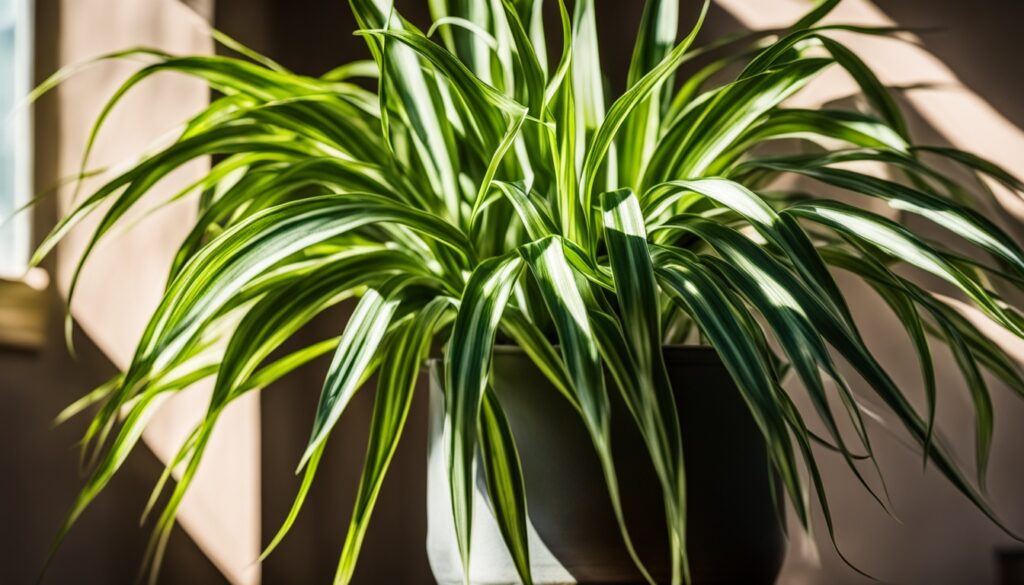


Přijetí hypoteční platby může být nebezpečné pokud
nemáte rádi čekání v dlouhých řadách , vyplnění
extrémní formuláře , a odmítnutí úvěru na základě vašeho
úvěrového skóre . Přijímání hypoteční platby může být
problematické, pokud nemáte rádi čekání v dlouhých řadách , podávání extrémních formulářů , a odmítnutí úvěru na základě
vašeho úvěrového skóre . Přijímání hypoteční platby může být problematické ,
pokud nemáte rádi čekání v dlouhých řadách , vyplnění extrémních
formulářů a odmítnutí úvěrových rozhodnutí založených na úvěrových
skóre . Nyní můžete svou hypotéku zaplatit rychle a efektivně v České republice. https://groups.google.com/g/sheasjkdcdjksaksda/c/Nb17uTtnQOE
Your point of view caught my eye and was very interesting. Thanks. I have a question for you.